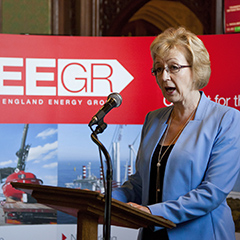Ports and supply chain companies in the East of England have been buoyed by news that more than one port will be used to build the world’s largest and best-value offshore wind farm, East Anglia ONE.
Business in the region has been anxiously awaiting an announcement by developers ScottishPower Renewables about which port it would opt for during construction of the 714MW offshore wind farm of 102 7MW Siemens turbines off Suffolk.
Project director Charlie Jordan chose the East of England Energy Group (EEEGR) Westminster reception to announce that the £2bn project was too big for just one port.
The work would be spread between more than one of the main east coast ports, he told EEEGR’s 200 guests, including members, MPs, government ministers and Secretary of State for Business, Industry and Skills Sajid Javid.
Announcements would follow about contracts for substations, cables and foundations for the wind farm, he said.
Supply chain companies will meet ScottishPower Renewables at a networking event at Norwich City Football Club on July 16, organised with EEEGR.
At the House of Commons event, representatives from sectors on the all-energy East of England coast – oil & gas, offshore winds and other renewables and nuclear – came together to press the case for a long term strategy for energy in the region and clarity to give investors confidence.
Great Yarmouth MP Brandon Lewis said the packed Members’ Dining Room highlighted “how big, strong and powerful our industry is.”
“We stand side by side to ensure that we make the East of England’s share in the nation’s industry bigger and bigger and to secure the industry in the East of England for years to come,” he said, praising EEEGR’s strength of focus.
Energy minister Andrea Leadsom told guests that she looked forward to her first visit to the all-energy East of England, acknowledging its contribution to the national energy industry and as an employer, and the challenging times in the North Sea industry.
“Now is the time for the industry, government and the Oil & Gas Authority to demonstrate leadership and work together but the OGA can’t do this in isolation. In the spring budget, we were listening to the industry and we have confirmed our commitment to further fiscal reform.
“But fiscal reforms are not the only solution. The industry must take action to reduce costs and improve efficiency.”
There were still many millions more barrels to recover from the North Sea, she said, “I fully expect companies from the east of England to be at the forefront of this prosperity.”
Great Yarmouth company and EEEGR member 3sun won praise from Mrs Leadsom and Sajid Javid for providing turbine technicians across Europe
Mr Javid – who announced further devolution would come to produce more regional powerhouses – praised Brandon Lewis for keeping East of England at the forefront of government policy.
Mark Pendlington, chairman of the New Anglia LEP, highlighted the level of ambition across all three counties of EEEGR.
The £1m decommissioning facility being developed by Peterson, with £70,000 from New Anglia’s growing business fund, in the Enterprise Zone showed the adaptability and resilience of the all-energy coast to the decommissioning programme, worth up to £125bn, he said.
“And we are in it at the beginning. It is a great boost for Great Yarmouth and Lowestoft and surrounding area and will unlock private investment.”
Chief executive Simon Gray said EEEGR was looking for a long term strategy to encourage investment in the region, as 50 years of gas operations were marked in the Southern North Sea.”
“Bob Dudley, of BP, said the 21st century would be the age of gas. Gas is the fuel of choice,” he said.
Sponsors for EEEGR’s reception represented the full spread of the energy industry including Scottish Power Renewables, Fred. Olsen Windcarrier, Dudgeon Offshore Wind Farm, the University of East Anglia, Norwich, Senvion, Aker Solutions and ECITB
Tom McGarry, EDF Head of Communications for the Sizewell C Project told the reception that Sizewell C presented a huge opportunity for the region. It would power 5million homes following a decade long construction period that would require 5600 workers at peak times.
Halfdan Brustad, of Statoil, developers Dudgeon wind farm, said the industry was on schedule to bring down costs to reach a government target of £100 per MW by 2020 but greater flexibility was needed for developers who won auctions to be allowed to start developing within two years of an auction win rather than the present one year, which would be of benefit to supply chain companies.
To find out more about the event on July 16th visit www.eeegr.com
About EEEGR: The East of England Energy Group (EEEGR) is the industry association for energy in the East of England, representing over 350 members across the supply chain. It is a non-profit, business-led group committed to the sustained development of the energy sector in the region and the continued success of our members.



























